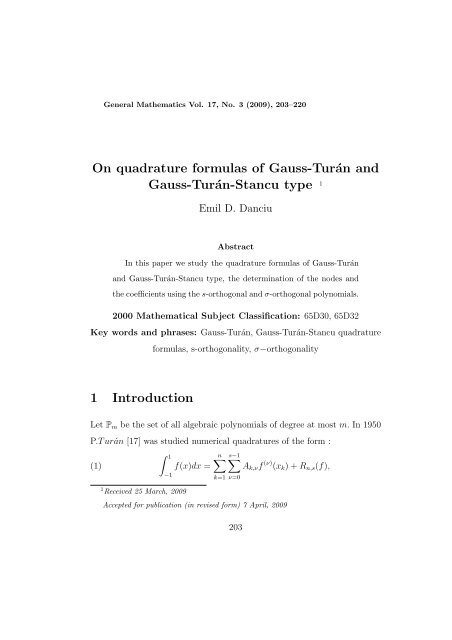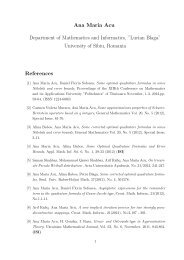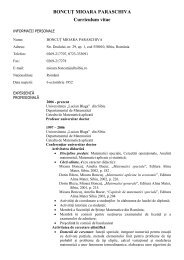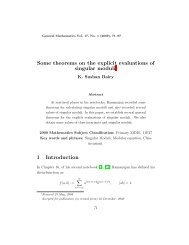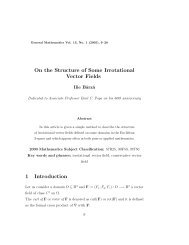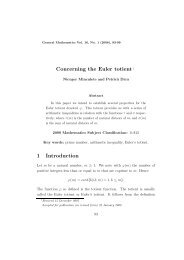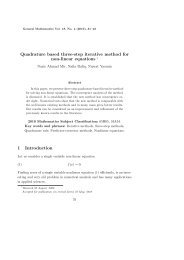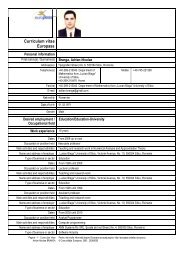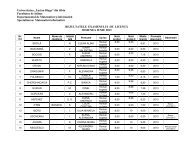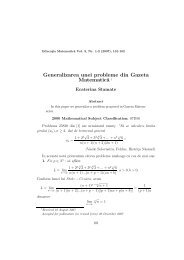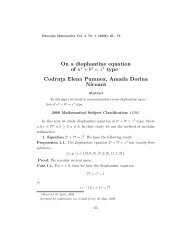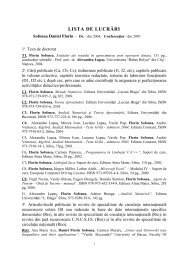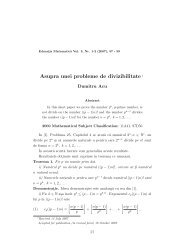On quadrature formulas of Gauss-Turan and Gauss
On quadrature formulas of Gauss-Turan and Gauss
On quadrature formulas of Gauss-Turan and Gauss
You also want an ePaper? Increase the reach of your titles
YUMPU automatically turns print PDFs into web optimized ePapers that Google loves.
General Mathematics Vol. 17, No. 3 (2009), 203–220<br />
<strong>On</strong> <strong>quadrature</strong> <strong>formulas</strong> <strong>of</strong> <strong>Gauss</strong>-Turán <strong>and</strong><br />
<strong>Gauss</strong>-Turán-Stancu type 1<br />
Emil D. Danciu<br />
Abstract<br />
In this paper we study the <strong>quadrature</strong> <strong>formulas</strong> <strong>of</strong> <strong>Gauss</strong>-Turán<br />
<strong>and</strong> <strong>Gauss</strong>-Turán-Stancu type, the determination <strong>of</strong> the nodes <strong>and</strong><br />
the coefficients using the s-orthogonal <strong>and</strong> σ-orthogonal polynomials.<br />
2000 Mathematical Subject Classification: 65D30, 65D32<br />
Key words <strong>and</strong> phrases: <strong>Gauss</strong>-Turán, <strong>Gauss</strong>-Turán-Stancu <strong>quadrature</strong><br />
1 Introduction<br />
<strong>formulas</strong>, s-orthogonality, σ−orthogonality<br />
Let Pm be the set <strong>of</strong> all algebraic polynomials <strong>of</strong> degree at most m. In 1950<br />
P.T urán [17] was studied numerical <strong>quadrature</strong>s <strong>of</strong> the form :<br />
(1)<br />
� 1<br />
−1<br />
1 Received 25 March, 2009<br />
f(x)dx =<br />
n� �s−1<br />
k=1 ν=0<br />
Ak,νf (ν) (xk) + Rn,s(f),<br />
Accepted for publication (in revised form) 7 April, 2009<br />
203
204 Emil D. Danciu<br />
where the nodes −1 ≤ x1 < · · · < xn ≤ 1 are arbitrary, Ak,ν = � 1<br />
−1 lk,ν(x)dx,<br />
(k = 1, n ; ν = 0, s − 1) <strong>and</strong> lk,ν(x) are the fundamental polynomials <strong>of</strong><br />
Hermite interpolation. The formula (1) is exact for any f ∈ Psn−1.<br />
<strong>On</strong>e raise the problem to determine, if it is possible the nodes {xi, i =<br />
1, n} so that the <strong>quadrature</strong> formula is exact for all f ∈ P(s+1)n−1. Turán<br />
showed that the nodes must have odd multiplicities to obtain an increase<br />
<strong>of</strong> degree <strong>of</strong> exactness <strong>and</strong> these nodes must be the zeros <strong>of</strong> the monic<br />
polynomial π ∗ n(x) = x n + an−1x n−1 + · · · + a1x + a0, which minimizes the<br />
value <strong>of</strong> the integral � 1<br />
−1 [πn(x)] s+1 dx.<br />
If one consider the odd orders <strong>of</strong> multiplicity <strong>of</strong> the nodes to be 2s + 1<br />
then one obtain the <strong>Gauss</strong>-Turán type <strong>quadrature</strong> formula :<br />
(2)<br />
� b<br />
a<br />
f(x)dλ(x) =<br />
n� �2s<br />
k=1 ν=0<br />
Ak,νf (ν) (xk) + Rn,2s(f),<br />
where dλ(x) is a nonnegative measure on the interval (a, b) which can be<br />
the real axis R , with compact or infinite support for which all moments:<br />
µk = � b<br />
a xk dλ(x), k = 0, 1, . . . , exists, are finite, <strong>and</strong> µ0 > 0.<br />
If the nodes {xk, k = 1, n} in (2) are chosen the zeros <strong>of</strong> the monic<br />
polynomial πn,s = πn,s(x) which minimizes the integral.<br />
(3) F (a0, a1, . . . , an−1) =<br />
� b<br />
a<br />
[πn(x)] 2s+2 dλ(x),<br />
then the formula (2) is exact for all polynomials <strong>of</strong> degree at most<br />
2(s + 1)n − 1 , that is, Rn,2s(f) = 0, ∀f ∈ P2(s+1)n−1. The condition (3) is<br />
equivalent with the following conditions:<br />
(4)<br />
� b<br />
[πn(x)]<br />
a<br />
2s+1 x k dλ(x) = 0, (k = 0, n − 1).
<strong>On</strong> <strong>quadrature</strong> <strong>formulas</strong> <strong>of</strong> <strong>Gauss</strong>-Turán <strong>and</strong> <strong>Gauss</strong>-Turán-Stancu... 205<br />
Let denote, πn,s(x) by Pn,s(x) . The case dλ(x) = w(x)dx on [a, b] has been<br />
studied by Osscini <strong>and</strong> Ghizzetti.<br />
2 The construction <strong>of</strong> GAUSS-TURÁN Quadra-<br />
ture Formulas by using s-Orthogonal <strong>and</strong><br />
σ-Orthogonal Polynomials<br />
In order to numerically construct the s-orthogonal polynomials with respect<br />
to the measure dλ(x), one can use the orthogonality conditions (4). Let n<br />
<strong>and</strong> s be given, <strong>and</strong> the measure : dµ(x) = dµn,s(x) = (πn(x)) 2s dλ(x). Then<br />
the orthogonality conditions can be written as: � b<br />
a πn,s<br />
k (x)tν dµ(x) = 0, (ν =<br />
0, k − 1), where {π n,s<br />
k }k∈N is a sequence <strong>of</strong> monic orthogonal polynomials<br />
with respect to the new measure dµ(x).<br />
So, the polynomials π n,s<br />
k , which we will denote by πk = πk(x) satisfies a<br />
three-term recurrence relation <strong>of</strong> the form :<br />
(5) πk+1(x) = (x − αk)πk(x) − βkπk−1(x),<br />
where π−1(x) = 0, π0(x) = 1, <strong>and</strong> we have from the orthogonality property:<br />
β0 = � b<br />
a dµ(x),<br />
(6)<br />
αk = < xπk, πk ><br />
< πk, πk > =<br />
� b<br />
a xπ2 k (x)dµ(x)<br />
� b<br />
a π2 k (x)dµ(x) , βk = < πk, πk ><br />
< πk−1, πk−1 > =<br />
� b<br />
a π2 k (x)dµ(x)<br />
� b<br />
a π2 k−1 (x)dµ(x).<br />
<strong>On</strong>e can calculate the coefficients αk, βk, (k = 0, n − 1), <strong>and</strong> are ob-<br />
tained the first n + 1 orthogonal polynomials π0, π1, . . . , πn, <strong>and</strong> let denote
206 Emil D. Danciu<br />
them by Pn,s = π s n.<br />
Let define the function on the Euclidian space R n<br />
(7) Φ(x1, . . . , xn) =<br />
� b<br />
a<br />
(x − x1) 2s+2 . . . (x − xn) 2s+2 dλ(x).<br />
If dλ(x) is a positive measure, it was proven that this function is continuous<br />
<strong>and</strong> positive. Then the function Φ(x1, . . . , xn) has an lower bound µ0 <strong>and</strong><br />
this value is attained for a < x1 < · · · < xn < b (see [8] T.Popoviciu).<br />
Let consider the polynomial P 2s+2<br />
n,s (x) = � n<br />
k=1 (x−xk) 2s+2 with the zeros<br />
a < x1 < · · · < xn < b.<br />
Then the function Φ(x1, . . . , xn) have a relative minimum point <strong>and</strong> we<br />
have: − 1<br />
∂Φ<br />
2s+2<br />
� b<br />
a<br />
∂xk = I(Pk) = 0, where Pk(x) =<br />
2s+2<br />
Pn,s (x)<br />
x−xk<br />
. Then one must have:<br />
P 2s+1<br />
n,s lk(x)dλ(x) = 0, k = 1, n , where lk(x), k = 1, n<br />
are the Lagrange’s fundamental interpolation polynomials corresponding to<br />
the nodes : x1, . . . , xn, which are linearly independent. Thus, one obtain<br />
that the polynomial P 2s+1<br />
n,s<br />
� b<br />
a<br />
satisfies the orthogonality conditions :<br />
� Pn,s(x) � 2s+1 x k dλ(x) = 0, k = 0, n − 1.<br />
From the condition to have a relative minimum we obtain:<br />
∂Φ<br />
∂xk<br />
= 0,<br />
∂ 2 Φ<br />
∂xk∂xj<br />
= 0,<br />
∂ 2 Φ<br />
∂x 2 k<br />
> 0, k, j = 1, n , k �= j.<br />
It was showed that the remainder in (2) can be expressed as<br />
(8) R(f) = f (N) (ξ)<br />
N!<br />
� b<br />
a<br />
P 2s+2<br />
n,s dλ(x), N = 2(s + 1)n.
<strong>On</strong> <strong>quadrature</strong> <strong>formulas</strong> <strong>of</strong> <strong>Gauss</strong>-Turán <strong>and</strong> <strong>Gauss</strong>-Turán-Stancu... 207<br />
Now, we consider the following expression <strong>of</strong> the remainder in the quadra-<br />
ture formula (2) R(f; dλ) = � b<br />
U(x)D(f; x)dλ(x), where<br />
a<br />
n�<br />
u(x) = (x − xk) 2s+1 , U(x) = u(x)(x − x1) . . . (x − xn) =<br />
k=1<br />
<strong>and</strong> D(f; x) =<br />
⎡<br />
⎣ x, x1, x2, . . . xn; f<br />
1 2s + 1 2s + 1 . . . 2s + 1<br />
⎤<br />
⎦ .<br />
n�<br />
(x − xk) 2s+2<br />
If f ∈ C N (a, b), by using the Peano’s Theorem, then the remainder can<br />
be expressed as R[f] = � b<br />
a KN(t)f (N) (t)dλ(t), with N = 2(s + 1)n,<br />
where the Peano’s Kernel have the expression :<br />
KN(t) = Rx[ (x−t)N−1 + ], which is a spline function <strong>of</strong> degree N − 1 with the<br />
(N−1)!<br />
interpolation points in the nodes <strong>of</strong> the <strong>quadrature</strong> formula <strong>and</strong> the compact<br />
support [a, b]. Then we have:<br />
(9) KN(t) =<br />
� b<br />
a<br />
(x − t) N−1<br />
+<br />
dλ(t) −<br />
(N − 1)!<br />
n� �2s<br />
k=1 ν=0<br />
k=1<br />
(N − 1) [ν] (xk − t) N−ν−1<br />
+<br />
(N − 1)!<br />
Let n ∈ N, σ = (s1, . . . , sn) be a sequence <strong>of</strong> nonnegative integers, <strong>and</strong> the<br />
nodes xk ordered, say a ≤ x1 < x2 < · · · < xn ≤ b , with odd multiplicities<br />
2s1 + 1, . . . , 2sn + 1 , respectively.<br />
A generalization <strong>of</strong> the <strong>quadrature</strong> formula <strong>of</strong> <strong>Gauss</strong>-Turán type was<br />
given independently by Chakalov [2] <strong>and</strong> T.Popoviciu, [8], for the nodes xk<br />
with different multiplicities 2sk + 1, k = 1, n <strong>of</strong> the following form<br />
� b<br />
n� 2sk �<br />
(10)<br />
f(x)dλ(x) = Ak,νf (ν) (xk) + R(f),<br />
which have dmax = 2<br />
(11)<br />
a<br />
� b<br />
a<br />
n�<br />
ν=1<br />
k=1 ν=0<br />
n�<br />
sk + 2n − 1, if <strong>and</strong> only if<br />
k=1<br />
(x − xν) 2sν+1 x k dλ(x) = 0, k = 0, n − 1.<br />
.
208 Emil D. Danciu<br />
The conditions (11) defines a sequence <strong>of</strong> polynomials {πn,σ}n∈N0, πn,σ(x) =<br />
n�<br />
(x − xk), such that � b<br />
a πk,σ(x)<br />
n�<br />
(x − xν) 2sν+1<br />
dλ(x) = 0, k = 0, n − 1.<br />
k=1<br />
ν=1<br />
These polynomials are called σ-orthogonal polynomials <strong>and</strong> they corre-<br />
sponds to the sequence σ = (s1, s2, . . . , sn) <strong>of</strong> nonnegative integers.<br />
n�<br />
Definition 1 The polynomials Pn,σ(x) = (x−x n,σ<br />
ν ) are called σ−orthogonal,<br />
ν=1<br />
if they satisfies the orthogonality conditions � b<br />
0, n − 1, with respect to the weight wn,σ(x) = w(x)<br />
a Pn,σ(x) x j wn,σ(x)dx = 0, j =<br />
n�<br />
(x − x n,σ<br />
ν=1<br />
ν ) 2sν .<br />
It can be proved that the σ−orthogonal polynomial Pn,σ can be obtained<br />
by the minimization <strong>of</strong> the integral � b<br />
a w(x)<br />
n�<br />
(x − xν) 2sν+2<br />
dx.<br />
If we consider the vector <strong>of</strong> multiplicity orders σ = (2s+1, 2s+1, . . . , 2s+<br />
1), then the above polynomials reduces to the s-orthogonal polynomials.<br />
Let consider the Lagrange-Hermite interpolation polynomial<br />
⎛<br />
(12) (LHf)(x) = L ⎝ xk,<br />
⎞<br />
2sk + 1<br />
γj,<br />
1<br />
x;<br />
1<br />
f<br />
⎠<br />
on the nodes xk with the multiplicities 2sk + 1, k = 1, n <strong>and</strong> we apply the<br />
parameters method <strong>of</strong> D.D. Stancu.<br />
ν=1<br />
Then LHf can be expressed in the following form<br />
(13)<br />
⎛<br />
(LHf)(x) = v(x)LH ⎝ xk, x; f1<br />
⎠ + u(x)LH ⎝<br />
2sk + 1 1<br />
γj, x; f2<br />
⎠ , where<br />
1 1<br />
⎞<br />
u(x) = (x−x1) 2s1+1 (x−x2) 2s2+1 . . . (x−xn) 2sn+1 , v(x) = (x−γ1)(x−γ2) . . . (x−γn),<br />
⎛<br />
⎞
<strong>On</strong> <strong>quadrature</strong> <strong>formulas</strong> <strong>of</strong> <strong>Gauss</strong>-Turán <strong>and</strong> <strong>Gauss</strong>-Turán-Stancu... 209<br />
f1(x) = f(x)/v(x), f2(x) = f(x)/u(x).<br />
Note that v(x) is the polynomial <strong>of</strong> undetermined nodes. Then we have the<br />
following interpolation formula<br />
(14) f(x) = (LHf)(x) + (rf)(x), where<br />
(15)<br />
⎡<br />
(rf)(x) = u(x)v(x) ⎣ x1,<br />
⎤<br />
. . . , xn, γ1, . . . , γn x; f<br />
⎦ .<br />
2s1 + 1, . . . , 2sn + 1 1, . . . , 1 1<br />
By multiplying the Lagrange-Hermite formula (13) with the weight func-<br />
tion w = w(x) <strong>and</strong> by integrating on (a, b) with respect to the measure<br />
dλ(x) = w(x)dx, we obtain the <strong>quadrature</strong> formula<br />
(16) I(w; f) = Q(f) + G(f) + R(f),<br />
where R(f) = I(w, rf) , <strong>and</strong><br />
(17) G(f) =<br />
n�<br />
Bjf(γj).<br />
j=1<br />
<strong>On</strong>e can observe that in (15) , the divided difference which appears have<br />
n�<br />
n�<br />
the order N + 1 = 2 sk + 2n = 2S + 2n, where S = sk.<br />
k=1<br />
k=1<br />
Thus, the degree <strong>of</strong> exactness <strong>of</strong> (16) is N = 2S + 2n − 1.<br />
Remark 1 <strong>On</strong>e must determine the nodes xk, k = 1, n with the multiplic-<br />
ities 2sk + 1, (k = 1, n), so that B1 = · · · = Bn = 0, for any values <strong>of</strong> the
210 Emil D. Danciu<br />
parameters γj, j = 1, n, <strong>and</strong> it is necessary <strong>and</strong> sufficient that<br />
(18) � b<br />
a<br />
n�<br />
ν=1<br />
(x − xν) 2sν+1 x k dλ(x) = 0, k = 0, n − 1 , where dλ(x) = w(x)dx.<br />
<strong>On</strong>e can prove that the system (18) with the unknowns x1, x2, . . . , xn<br />
has at least a solution with distinct values. If f ∈ C N+1 (a, b), then the<br />
expression for the remainder will be R(f) = f (2S+2n) (ξ)K2S+2n, where<br />
K2S+2n =<br />
1<br />
(2S + 2n)! I(w; U2S+2n), U2S+2n =<br />
n�<br />
(x − xk) 2sk+2<br />
.<br />
k=1<br />
a) The determination <strong>of</strong> the <strong>Gauss</strong>ian nodes<br />
Let denote τk := xk the nodes <strong>of</strong> the <strong>quadrature</strong> (10), <strong>and</strong> {pj}j∈N0, let be<br />
a sequence <strong>of</strong> orthonormal polynomials with respect to the measure, dλ(t)<br />
on R. Then, these polynomials satisfy the three-term recurrence relation<br />
(19)<br />
� βj+1 pj+1(t) + αj pj(t) + � βj pj−1(t) = tpj(t), j = 0, 1, . . . ,<br />
where p−1(t) = 0, p0(t) = 1/ √ β0, β0 = µ0 = � b<br />
a dλ(t).<br />
For a given sequence σ = (s1, s2, . . . , sn) , the orthogonality conditions (18)<br />
can be written as<br />
�<br />
(20) Fj(t) =<br />
R<br />
�<br />
�n<br />
pj−1(t)<br />
ν=1<br />
(t − τν) 2sν+1<br />
�<br />
dλ(t) = 0, j = 1, n,<br />
where t = (τ1, . . . , τn) T , F(t) = [F1(t), F2(t), . . . , Fn(t)] T , which is a non<br />
linear system <strong>of</strong> equations.<br />
To solve the system (20) can be used the Newton-Kantorovic method (see<br />
[7]). <strong>On</strong>e can construct the iterative formula<br />
t (k+1) = t (k) − W −1 (t (k) )F(t (k) ), k = 0, 1, 2, . . .
<strong>On</strong> <strong>quadrature</strong> <strong>formulas</strong> <strong>of</strong> <strong>Gauss</strong>-Turán <strong>and</strong> <strong>Gauss</strong>-Turán-Stancu... 211<br />
where t (k) = (τ (k)<br />
1 , τ (k)<br />
2 , . . . , τ (k)<br />
n ) T , <strong>and</strong> W = W (t) = [wj,k]n×n = [ ∂Fj<br />
∂τk ]n×n, is<br />
the Jacobian <strong>of</strong> F(t) , whose elements can be calculated by<br />
wj,k = ∂Fj<br />
∂τk<br />
But, w0,k = 0 <strong>and</strong><br />
�<br />
= −(2sk + 1)<br />
R<br />
(21) w1,k = − 2sk + 1<br />
√ β0<br />
�<br />
R<br />
�<br />
pj−1(t) �n<br />
(t − τν)<br />
t − τk<br />
ν=1<br />
2sν+1<br />
�<br />
dλ(t), j, k = 1, n.<br />
(t − τk) 2sk<br />
�<br />
then, by integrating (19) one obtain<br />
n�<br />
ν=1,ν�=k<br />
(t − τν) 2sν+1 � dλ(t),<br />
(22) �βj+1 wj+2,k = (τk − αj) wj+1,k − � βj wj,k − (2sk + 1)Fj+1, j = 0, n − 2.<br />
Thus, knowing only Fj <strong>and</strong> w1,j, (j = 1, n), one can calculate the elements<br />
<strong>of</strong> the Jacobian matrix by the nonhomogenous recurrence relation (22).<br />
The integrals (20), (21), can be calculated by using a <strong>Gauss</strong>-Christ<strong>of</strong>fel<br />
<strong>quadrature</strong> formula, (w.r.t. the measure dλ(t) ) <strong>of</strong> the following form<br />
� b<br />
a<br />
g(t)dλ(t) =<br />
L�<br />
k=1<br />
A (L) (L)<br />
k g(τ k ) + RL(g),<br />
with L = � n<br />
k=1 sk + n, which is exact for ∀f ∈ P2L−1, where 2L − 1 =<br />
2 � n<br />
k=1 sk + 2n − 1.<br />
For a sufficiently good approximation t (0) , the convergence <strong>of</strong> the method<br />
for the calculation <strong>of</strong> t (k+1) is quadratic (see [7]).<br />
If one consider σ = (s, s, . . . , s), <strong>and</strong> the <strong>quadrature</strong> formula (2) then,<br />
in order to determine the coefficients αν, βν from the recurrence relation<br />
(5), can be used the discretized Stieltjes procedure for infinite intervals <strong>of</strong>
212 Emil D. Danciu<br />
orthogonality. From (5) one obtain the following nonlinear system<br />
�<br />
f0 ≡ β0− π<br />
R<br />
2s<br />
�<br />
n (t)dλ(t) = 0, f2ν+1 ≡ (αν−t)π<br />
R<br />
2 ν(t)π 2s<br />
n (t)dλ(t) = 0, (ν = 0, n − 1),<br />
f2ν ≡<br />
�<br />
R<br />
� βνπ 2 ν−1(t) − π 2 ν(t) � π 2s<br />
n (t)dλ(t) = 0, (ν = 0, n − 1).<br />
The polynomials π0, π1, . . . , πn can be expressed in terms <strong>of</strong> αν, βν, ν =<br />
0, n, by the recurrence relation (5).<br />
By using the Newton-Kantorovic’s method, one obtain the following<br />
relations for the determination <strong>of</strong> the coefficients in (5), namely x (k+1) =<br />
x (k) −W −1 (x (k) )f(x (k) ), k = 0, 1, . . . , where the zeros τ = τ(s, n), (ν = 1, n)<br />
<strong>of</strong> π s,n<br />
n are the nodes <strong>of</strong> <strong>Gauss</strong>-<strong>Turan</strong>’s type <strong>quadrature</strong> formula.<br />
Note that these zeros can be obtained by using the QR algotithm, which<br />
determines the eigenvalues <strong>of</strong> a symmetric tridiagonal Jacobi matrix Jn<br />
⎛<br />
⎜<br />
Jn = ⎜<br />
⎝<br />
α0<br />
√<br />
β1 α1<br />
√ β1 0 0 . . . 0 0<br />
√ β2<br />
. . . . . . . . . . . . . . . . . . . . .<br />
0 0 0 . . . � βn−2 αn−2<br />
0 0 0 . . . 0<br />
� βn−1<br />
� βn−1 αn−1<br />
⎞<br />
⎟ .<br />
⎟<br />
⎠<br />
This algorithm can be used to determine the s− or σ−orthogonal poly-<br />
nomials by constructing MATLAB routines for some <strong>Gauss</strong>-Christ<strong>of</strong>fel quadra-<br />
ture <strong>formulas</strong> <strong>and</strong> routines to solve some systems <strong>of</strong> equations.<br />
b) The determination <strong>of</strong> the coefficients<br />
Let denote U(t) = � n<br />
k=1 (t − τk) 2sk+1 , <strong>and</strong> let consider the Hermite interpo-
<strong>On</strong> <strong>quadrature</strong> <strong>formulas</strong> <strong>of</strong> <strong>Gauss</strong>-Turán <strong>and</strong> <strong>Gauss</strong>-Turán-Stancu... 213<br />
lation formula<br />
(23) f(t) = (Hf)(t)+(Rf)(t) =<br />
i (t−τν) �<br />
hν,i(t)=<br />
i!<br />
2sν−i �<br />
k=0<br />
(t−τν) k<br />
k!<br />
By integrating (23), one obtain<br />
Aν,i =<br />
� b<br />
a<br />
hν,i(t)dλ(t)= 1<br />
2sν−i �<br />
i!<br />
k=0<br />
= 1<br />
2sν−i �<br />
i!<br />
k=0<br />
1<br />
k!<br />
Let denote Uν;i+k(t) =<br />
n�<br />
ν=1<br />
2sν �<br />
i=0<br />
� 1 � (k) �<br />
Uν(t), Uν(t)=<br />
t=τν Uν(t)<br />
1<br />
k!<br />
� (t − τν) 2sν+1<br />
U(t)<br />
� (t−τν) 2sν+1<br />
U(t)<br />
� (k)<br />
t=τν<br />
U(t)<br />
(t−τν) 2sν −i−k+1 =<br />
� b<br />
a<br />
hν,i(t)f (i) (τν)+(Rf)(t), where<br />
� (k)<br />
t=τν<br />
� b<br />
a<br />
n�<br />
(t−τk) 2sk+1<br />
/(t−τν) 2sν+1 .<br />
k=1<br />
i+k U(t)dλ(t)<br />
(t−τν)<br />
(t−τν)<br />
U(t)<br />
dλ(t).<br />
(t − τν) 2sν−i−k+1<br />
2sν+1 =<br />
= (t−τν) i+k ×(t−τ1) 2s1+1 . . . (t−τν−1) 2sν−1+1 (t−τν+1) 2sν+1+1 . . . (t−τn) 2sn+1 , where<br />
deg(Uν;i+k) ≤ 2sν +(2s1+1)+· · ·+(2sν−1+1)+(2sν+1+1)+· · ·+(2sn+1) =<br />
n�<br />
n�<br />
= 2 sν + n − 1 ≤ 2( sν + n) − 1 = 2N − 1 = dmax, N = 2(S + n)<br />
ν=1<br />
So, one obtain<br />
(24) Aν,i = 1<br />
2sν−i �<br />
i!<br />
k=0<br />
ν=1<br />
1<br />
k!<br />
� (t − τν) 2sν+1<br />
U(t)<br />
� (k)<br />
t=τν<br />
� b<br />
for ν = 1, n; i = 0, 1, . . . , 2sν <strong>and</strong> deg(Uν;i+k) ≤ 2N − 1.<br />
a<br />
Uν;i+k(t)dλ(t),<br />
The integrals � b<br />
a Uν,i+k(t)dλ(t), ν = 1, n; i = 0, 2sν, k = 0, 2sν − i, can<br />
be calculated by applying the <strong>quadrature</strong> formula<br />
� b<br />
a<br />
g(t)dλ(t) =<br />
with N = � n<br />
ν=1 sν + n nodes.<br />
N�<br />
k=1<br />
A (N) (N)<br />
k g(τ k ) + RN(g),
214 Emil D. Danciu<br />
3 A generalization given by D.D.Stancu to<br />
the <strong>Gauss</strong>-Turán type <strong>quadrature</strong> formula<br />
A generalization <strong>of</strong> the Turán <strong>quadrature</strong> formula (2) to <strong>quadrature</strong>s having<br />
nodes with arbitrary multiplicities was derived independently by Chakalov<br />
[2] <strong>and</strong> T. Popoviciu [8].<br />
D.D. Stancu in [14], [16], was bring very important contributions in this<br />
domain, by investigating <strong>and</strong> constructing so-called <strong>Gauss</strong>-Stancu quadra-<br />
ture <strong>formulas</strong> having multiple fixed nodes <strong>and</strong> simple or multiple free (Gaus-<br />
sian) nodes.<br />
Let ai, i = 1, n fixed (or prescribed) nodes, with the given multiplicities<br />
mi, i = 1, n , <strong>and</strong> x1 < x2 < · · · < xm be the free nodes with given<br />
multiplicities n1, . . . , nm . Then, we have the general <strong>quadrature</strong> <strong>of</strong> <strong>Gauss</strong>-<br />
Stancu type for the integral<br />
I[f] = � b<br />
f(x)dλ(x), (dλ(x) = w(x)dx) <strong>of</strong> the form<br />
a<br />
(25) Q[f] =<br />
(26)<br />
We denote<br />
ω(x) = α<br />
n�<br />
i=1<br />
mi−1 �<br />
ν=0<br />
n�<br />
(x − ai) mi , u(x) =<br />
i=1<br />
Bi,νf (ν) (ai) +<br />
m�<br />
k=1<br />
nk−1 �<br />
ν=0<br />
m�<br />
(x − xk) nk , M =<br />
k=1<br />
Ak,νf (ν) (xk).<br />
n�<br />
mi, N =<br />
i=1<br />
m�<br />
nk.<br />
The <strong>quadrature</strong> formula (25) have interpolatory type with the algebraic<br />
degree <strong>of</strong> exactness at least d ∗ = M +N −1 , if I(f) = Q(f), ∀f ∈ PM+N−1.<br />
The free nodes xk, k = 1, m can be chosen to increase the degree <strong>of</strong><br />
k=1
<strong>On</strong> <strong>quadrature</strong> <strong>formulas</strong> <strong>of</strong> <strong>Gauss</strong>-Turán <strong>and</strong> <strong>Gauss</strong>-Turán-Stancu... 215<br />
exactness, <strong>and</strong> so one can obtain I[f] = Q[f], ∀ f ∈ PM+N+n−1.<br />
D.D. Stancu gave the following characterizations<br />
Theorem 1 The nodes x1, . . . , xm are the <strong>Gauss</strong>ian nodes if <strong>and</strong> only if<br />
(27)<br />
� b<br />
a<br />
x k ω(x)u(x)dλ(x) = 0, ∀k = 0, m − 1.<br />
Theorem 2 If the multiplicities <strong>of</strong> the <strong>Gauss</strong>ian nodes are all odd , nk =<br />
2sk + 1, (k = 1, m) <strong>and</strong> if the multiplicities <strong>of</strong> the fixed nodes are even,<br />
mi = 2ri , i = 1, n , then there exist the real distinct nodes: xk, k = 1, m ,<br />
which are the <strong>Gauss</strong>ian nodes for the <strong>quadrature</strong> formula <strong>of</strong> <strong>Gauss</strong>-Turán-<br />
Stancu type (25).<br />
In this case, the orthogonality conditions (27) can be written as<br />
� b<br />
a<br />
x k πm(x)dµ(x), k = 0, m − 1, where πm(x) =<br />
k=1<br />
m�<br />
(x − xk),<br />
k=1<br />
m�<br />
dµ(x) = ( (x − xk) 2sk<br />
n�<br />
)( (x − ai) 2ri )dλ(x).<br />
This fact means that the polynomial πm(x) is orthogonal with respect to<br />
the new nonnegative measure dµ(x), <strong>and</strong> therefore , all zeros x1, . . . , xm are<br />
i=1<br />
simple, real <strong>and</strong> belongs to supp(dµ) = supp(dλ).<br />
<strong>On</strong>e can observe that the measure dµ(x) , contains the nodes x1, . . . , xm<br />
, i.e. the unknown polynomial πm(t) is implicitly defined.<br />
Let now consider the sets <strong>of</strong> fixed <strong>and</strong> <strong>Gauss</strong>ian nodes Fn = {a1, . . . , an},<br />
�<br />
Gm = {x1, . . . , xm} <strong>and</strong> let Fn Gm = ∅, <strong>and</strong> denote Xp = {ξ1, . . . , ξp} :=<br />
�<br />
Gm, (p = n + m) with the multiplicity <strong>of</strong> the node ξk be rk, k = 1, p.<br />
Fn
216 Emil D. Danciu<br />
Then can be determined the coefficients Ci,ν (i.e. Ai,ν <strong>and</strong> Bi,ν ) by using<br />
an interpolatory formula <strong>of</strong> the form<br />
� b<br />
p�<br />
(28)<br />
f(t)dλ(t) =<br />
a<br />
i=1<br />
rν−1 �<br />
ν=0<br />
Ci,νf (ν) (ξi) + Rp(f).<br />
Note that the multiplicity <strong>of</strong> the <strong>Gauss</strong>ian nodes are odd numbers.<br />
Example 3.1<br />
If (a, b) = (−1, 1), w(x) = (1 − x) α (1 + x) β , α, β > −1, <strong>and</strong> a0 =<br />
−1, a1 = 1 are simple fixed nodes, x0 is a simple free node, then the highest<br />
degree <strong>of</strong> exactness will be D = (1 + 1) + 1 = 3 which will be obtained for<br />
x0 = β−α<br />
. The corresponding <strong>quadrature</strong> formula <strong>of</strong> <strong>Gauss</strong>-Christ<strong>of</strong>fel-<br />
α+β+4<br />
Stancu type will be<br />
� 1<br />
(1−x)<br />
−1<br />
α (1+x) β f(x)dx=2 α+β+1<br />
Γ(α+1)Γ(β+1) � 2<br />
(α+1)(α+2) f(−1)+<br />
(α+2)(β+2)Γ(α+β+4)<br />
+(α+1)(β+1)(α+β+4) 2 f( β−α<br />
α+β+4 +(β + 1)(β + 2)2 f(1) � −<br />
−2 α+β+2 Γ(α + 3)Γ(β + 3)<br />
3(α + β + 4)Γ(α + β + 6) f IV (ξ).<br />
Example 3.2 Let u(x) = � m+1<br />
i=0 (x − xi) ri , be the polynomial <strong>of</strong> nodes<br />
with the following multiplicities x0 = a, r0 = p+1, xm+1 = b, rm+1 = q +1,<br />
the fixed nodes <strong>and</strong> the <strong>Gauss</strong>ian nodes xi, ri = 2s + 1, (i = 1, m).<br />
Then we can construct the <strong>quadrature</strong> formula <strong>of</strong> <strong>Gauss</strong>-Stancu type<br />
with fixes nodes x0 = a, xm+1 = b, with the above given multiplicity<br />
orders.<br />
(29)<br />
� b<br />
a<br />
f(x)w(x)dx=<br />
p�<br />
i=0<br />
A0,if (i) (a)+<br />
q�<br />
j=0<br />
Am+1,jf (j) (b)+<br />
m� �2s<br />
k=1 ν=0<br />
Ak,νf (ν) (xk)+R(f),
<strong>On</strong> <strong>quadrature</strong> <strong>formulas</strong> <strong>of</strong> <strong>Gauss</strong>-Turán <strong>and</strong> <strong>Gauss</strong>-Turán-Stancu... 217<br />
with the polynomial <strong>of</strong> fixed nodes ω(x) = (x − a) p+1 (b − x) q+1 . For a given<br />
s ∈ N, the polynomial Pm,s is orthogonal on [a, b] with respect to the weight<br />
function w(x), if this polynomial is chosen as the solution <strong>of</strong> the extremal<br />
2s+2 P a m,s w(x)dx = min, which is equivalent with the condition that<br />
� b 2s+1 P a m,s (x)xkw(x)dx = 0, k = 0, m − 1.<br />
problem � b<br />
Then the last one condition can be interpreted as a orthogonality condition<br />
with respect to the weight function p(x) = ω(x)P 2s<br />
m,s(x).<br />
We use a method given by D.D Stancu in [12]. Let consider the auxiliary<br />
function<br />
(30) ϕi(x) = 1<br />
� b<br />
ui(x) a<br />
We have<br />
m� �2s<br />
k=1 ν=0<br />
Ak,νf (ν) (xk) =<br />
hi,k(x) =<br />
u(x) − u(t)<br />
w(t)dt, where ui(x) = u(x)/(x − xi)<br />
x − t<br />
ri .<br />
m� ri−1 �<br />
� � b<br />
i=1<br />
(x − xi) k<br />
k!<br />
k=0<br />
ri−1−k �<br />
j=0<br />
a<br />
�<br />
hi,k(x)w(x)dx f (k) (xi), where<br />
�(x − xi) j<br />
j!<br />
� 1<br />
ui(x)<br />
� (j)<br />
xi<br />
� ui(x).<br />
Let ni = ri − k − 1, <strong>and</strong> calculate the expression using the Leibniz’s formula<br />
� � b<br />
a<br />
ϕ (ni)<br />
i (x) =<br />
ni �<br />
j=0<br />
� �<br />
ni � 1<br />
� �<br />
� b<br />
(j)<br />
j ui(x) a<br />
u(x) − u(t)<br />
w(t)dt<br />
x − t<br />
� (k)<br />
=<br />
k�<br />
ν=0<br />
� k<br />
ν<br />
� � b<br />
� (ni−j)<br />
u(x) − u(t)<br />
w(t)dt , where<br />
x − t<br />
a<br />
� 1 � (ν)[u(x)−u(t)] (k−ν)<br />
w(t)dt.<br />
x − t<br />
If x = α is a zero <strong>of</strong> order r, r > k for the polynomial u(x), then one obtain<br />
� � b<br />
a<br />
u(x) − u(t)<br />
w(t)dt<br />
x − t<br />
� (k)<br />
= −<br />
x=α<br />
� b<br />
a<br />
� 1 � (k)<br />
u(t)w(t)dt = . . .<br />
x − t x=α
218 Emil D. Danciu<br />
Then one obtain the expression<br />
ϕ (ri−k−1)<br />
ri−k−1 �<br />
i (xi) = (ri − k − 1)!<br />
j=0<br />
� b<br />
u(t)<br />
= k!<br />
w(t)dt.<br />
a (x − α) k+1<br />
1 � 1<br />
j! ui(x)<br />
� b<br />
u(x)<br />
= (ri − k − 1)!<br />
a (x − xi) ri−k<br />
� ri−k−1 �<br />
j=0<br />
�<br />
� b<br />
(j)<br />
xi<br />
a<br />
(x − xi) j<br />
j!<br />
u(x)<br />
w(x)dx =<br />
(x − xi) ri−k−j<br />
� 1<br />
ui(x)<br />
� (j)<br />
xi<br />
� w(x)dx.<br />
By integrating the Lagrange-Hermite interpolation formula <strong>and</strong> using the<br />
expression <strong>of</strong> hi,k(x), finally one obtain the following expression for the<br />
coefficients <strong>of</strong> the <strong>quadrature</strong> formula<br />
Ai,k =<br />
1<br />
k!(ri − k − 1)! ϕ(ri−k−1)<br />
i (xi).<br />
Note that the <strong>quadrature</strong> formula (29) is called the <strong>Turan</strong>-Ionescu formula.<br />
References<br />
[1] Acu D., <strong>On</strong> the D.D.Stancu method <strong>of</strong> parameters, Studia Univ. Babe¸s-<br />
Bolyai, Mathematica, 47(1997), 1-7.<br />
[2] Chakalov L., General <strong>quadrature</strong> formulae <strong>of</strong> <strong>Gauss</strong>ian type, Bulgar.<br />
Akad. Nauk. Izv. Mat. Inst., Vol. 1 (1954), 67-84 (Bulgarian) (English<br />
transl. East J.Approx., vol.1, (1995), 261-276).<br />
[3] Gautschi W., Milovanovic G., S-orthogonality <strong>and</strong> construction <strong>of</strong><br />
<strong>Gauss</strong>-<strong>Turan</strong>-type <strong>quadrature</strong> formulae, J.Comp.<strong>and</strong> Appl., Math.,<br />
86(1997), 205-218.
<strong>On</strong> <strong>quadrature</strong> <strong>formulas</strong> <strong>of</strong> <strong>Gauss</strong>-Turán <strong>and</strong> <strong>Gauss</strong>-Turán-Stancu... 219<br />
[4] Gori L., Stancu D.D., Mean value formulae for integrals involv-<br />
ing generalized orthogonal polynomials, Rev.Anal.Numer.Theorie de<br />
l’Approximation, 27(1998), 107-115.<br />
[5] Milovanovic G.V., S-orthogonality <strong>and</strong> generalized <strong>Turan</strong> quadra-<br />
ture, Construction <strong>and</strong> application, ICAOR, Cluj-Napoca, Romania,<br />
(Stancu D.D.ed.) Transilvania Press, (1997), 91-106.<br />
[6] Milovanovic G.V., Spalevic M.M., Construction <strong>of</strong> Chakalov-<br />
Popoviciu’s type <strong>quadrature</strong> formulae, Rend. Circ.Mat. Palermo, 2<br />
II,Suppl. 52(1998), 625-636.<br />
[7] Milovanović G.V., M.M. Spalević Quadratures <strong>of</strong> <strong>Gauss</strong>-Stancu Type:<br />
Construction <strong>and</strong> Error Analysis, Numerical Analysis <strong>and</strong> Approxima-<br />
tion Theory, Edt. R.Trambitas, Procc. <strong>of</strong> International Symposium on<br />
Numerical Analysis <strong>and</strong> Approximation Theory, Cluj-Napoca 9-11 may<br />
2002, pg. 314.<br />
[8] Popoviciu T., Asupra unei generalizări a formulei de integrare nu-<br />
merică a lui <strong>Gauss</strong>, Stud.Cerc.S¸tiint¸if. Acad.Ia¸si, 6(1955), 29-57.<br />
[9] Stancu D.D., Sur quelques formules generales de <strong>quadrature</strong> du type<br />
<strong>Gauss</strong>-Christ<strong>of</strong>fel, Mathematica, Cluj, 1(24)(1958), 167-182.<br />
[10] Stancu D.D., Asupra formulelor de cuadratură de tip <strong>Gauss</strong>, Studia<br />
Unv.Babe¸s-Bolyai, Mathematica, 3(1958), 71-84.<br />
[11] Stancu D.D., O metodă pentru construirea de formule de cuadratură<br />
de grad înalt de exactitate, Comunic.Acad.R.P.R., 8(1958), 349-358.
220 Emil D. Danciu<br />
[12] Stancu D.D., Asupra unor formule generale de integrare numerică ,<br />
Acad.R.P.Romane, Studii, Cerc. Matem., 9(1958), 209-216.<br />
[13] Stancu D.D., Numerical integration <strong>of</strong> functions by <strong>Gauss</strong>-<strong>Turan</strong>-<br />
Ionescu type <strong>quadrature</strong>s (I.A. Rus ed.), volum dedicat lui D.V. Ionescu<br />
la a 80-a aniversare a zilei de nastere<br />
[14] Stancu D.D., Stroud A.H., Quadrature <strong>formulas</strong> with simple <strong>Gauss</strong>ian<br />
nodes <strong>and</strong> multiple fixed nodes, Mathematics <strong>of</strong> computation, 1(1963),<br />
384-394.<br />
[15] Stancu D.D., Gh. Coman, P.Blaga, Analiză Numerică ¸si Teoria<br />
Aproximării, Vol. II, Presa Universitară Clujană, Cluj-Napoca (2002).<br />
[16] Stroud A.H., Stancu D.D., Quadrature <strong>formulas</strong> with multiple <strong>Gauss</strong>ian<br />
nodes, SIAM J.Numer.Anal., 2(1965), 129-143.<br />
[17] <strong>Turan</strong> P., <strong>On</strong> the theory <strong>of</strong> the mechanical <strong>quadrature</strong>, Acta.Sc.Math.,<br />
Szeged, 12(1950), 30-37.<br />
SEmil D. Danciu<br />
Str. V. Goldi¸s, no. 51 A,<br />
510018 - Alba-Iulia, Romania<br />
e-mail: nemil danciu@yahoo.com


